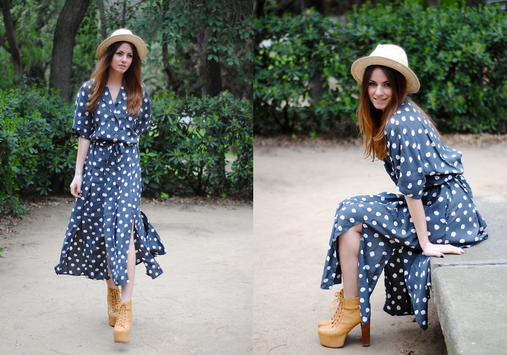
The popular elements from the vintage clothing
usinfo | 2013-05-23 10:24

Vintage clothing is a generic term for new or second hand garments originating from a previous era. The phrase is also used in connection with a retail outlet, e.g. "vintage clothing store."

Definition
Generally speaking, clothing which was produced before the 1920s is referred to as antique clothing and clothing from the 1920s to 20 years before the present day is considered vintage.Retro, short for retrospective, or "vintage style" usually refers to clothing that imitates the style of a previous era. Reproduction, or repro, clothing is a newly-made, copy of an older garment. Clothing produced more recently is usually called modern or contemporary fashion. Opinions vary on these definitions.
Most vintage clothing has been previously worn, but a small percentage of pieces have not. These are often old warehouse stock, and more valuable than those that have been worn, especially if they have their original tags.
Referred to as deadstock or new old stock (NOS), they nevertheless sometimes have flaws. Vintage clothing may be either commercially produced or handmade by individuals.
Vintage inspired and vintage style
Fashion design, throughout history has turned to previous eras for inspiration. Garments closely resembling original vintage (retro or antique) clothing are mass produced, for the most part, in China. An example of this is the simple slip dresses that emerged in the early 1990s, a style that resembles a 1930's design, but upon examination will show that it only superficially resembles the real thing. These styles are generally referred to as "vintage style", "vintage inspired" or "vintage reproductions". They serve as a convenient alternative to those who admire an old style but prefer a modern interpretation. Sellers claim consumer advantage in that, unlike the original garments, they are usually available in a range of sizes and perhaps, colours and/or fabrics, and can be sold much cheaper. However, as stated, these garments are mass produced, and do not have the fabric or quality of workmanship that is found in authentic vintage clothing. They really do not have a place in the vintage clothing market, since the items are not vintage, and are not unique, which is the mainstay of the industry. The sale of "vintage inspired" clothing is seen by some collectors as deceptive practice within the industry. The styles are made to look similar, but not only are they modern day and mass produced, they will not retain any value in the vintage clothing market. "Vintage inspired" garments do not have any of the merit that is embodied in authentic vintage clothing.
Vintage styles and vintage inspired clothing have not legitimately earned the title "vintage", because quite simply, they are not vintage, and it is misleading to consumers. In essence, vintage clothing retains and increases in value due to the fact that it is genuinely from a past era. In addition, authentic garments are made one at a time, with enough attention to detail to create an item that has long lasting value. Therefore, those items have proven merit, which has stood the test of time. The only modern day clothing that fits into the category of "collectible clothing" are couture quality pieces that are very expensive and well made.
There is a timelessness surrounding superior quality and design. It is most unfortunate that, along with the increased demand for vintage clothing, there has been a concurrent objective to mix it with the contemporary mass-produced "vintage inspired" designs, in order to capitalize on the growth of interest in authentic vintage clothing. In essence, all clothing is vintage inspired, and always has been. It does not mean that it is vintage. The distinction needs to be made clear. Consumers are increasingly savvy to misleading advertising with regards to vintage clothing, including all manner of mass-produced designer fakes and knock-offs within the fashion industry.
Share this page



















